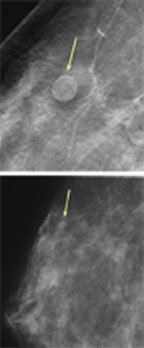3-D Vision: New technique could improve breast cancer screening, diagnosis
An experimental alternative to standard mammography could, by the end of this decade, become an essential tool for spotting breast cancer. The technique, called tomosynthesis, provides radiologists with a three-dimensional view of the breast’s inner structure. It enables them to recognize as harmless many of the areas that appear suspicious on conventional mammograms. The method may also identify tumors that current tests miss.

This now-experimental approach will not win federal approval for general practice until at least 2007, according to companies that intend to sell tomosynthesis devices. Eventually, however, the method could dominate breast-cancer screening, says Elizabeth A. Rafferty of Massachusetts General Hospital in Boston.
“Initially, it may be complementary to mammography and eventually move toward replacement . . . as people become comfortable with the technique,” Rafferty said on Nov. 30 in Chicago at a meeting of the Radiological Society of North America.
Tomosynthesis is a technological outgrowth of digital mammography, which captures and displays X-ray images electronically rather than on film. The digital
X-ray method has been in limited use since 2000 and is more effective than film mammography for spotting suspicious masses in some women (SN: 9/24/05, p. 198: Available to subscribers at Sharpening the focus of mammograms).
Both of the approved methods produce two views of a breast. Each view artificially flattens the breast’s inner features into two dimensions, sometimes hiding tumors from radiologists’ eyes. “Overlapping structures can also mimic abnormality when in fact no abnormality exists,” Rafferty says.
By contrast, tomosynthesis integrates up to 25 X-ray exposures per breast. Each exposure is taken from a different vantage point along an arc. The multiple perspectives enable a computer to generate a 3-D map of the breast. Doctors can then examine virtual slices of tissue millimeter by millimeter.
The radiation dose from tomosynthesis is equal to or less than that of a standard, two-view mammogram, says physicist Loren T. Niklason of Hologic in Bedford, Mass. The company is one of several developing tomosynthesis machines.
Assuming that tomosynthesis is commercialized, Niklason says, radiologists who possess digital-mammography equipment could upgrade at modest expense. However, current digital machines cost more than $300,000 apiece, which has slowed their acceptance. A film machine costs less than $100,000.
In a study sponsored by Hologic, Steven P. Poplack of Dartmouth-Hitchcock Medical Center in Lebanon, N.H., and his colleagues used a Hologic device to image the breasts of 98 women who had already had mammograms that required follow-up diagnostic procedures.
In about half of the cases, tomosynthesis revealed that the original concern had been unfounded.
Both techniques were imperfect. In the entire group, standard postmammogram testing found five tumors. Whether using mammography or tomosynthesis, radiologists had missed one of those tumors.
For visualizing the details of true abnormalities, tomosynthesis was better than mammography 35 percent of the time and inferior in 12 percent of cases, Poplack reported at the Chicago meeting.
Many researchers say that, compared with mammography, tomosynthesis could require less compression of the breasts. Although painful, compression is currently needed to maximize image clarity and minimize X-ray dose.
In a separate presentation at the Chicago meeting, Richard H. Moore of Massachusetts General Hospital said that he and his colleagues, including Rafferty, performed tomosynthesis on 470 women during the past decade. Of the 103 tumors eventually diagnosed, 7 had showed up in tomosynthesis but not on mammograms.
At the end of the symposium in which Rafferty spoke, a speaker asked the crowd of scientists and doctors whether tomosynthesis would replace mammography within about 5 years. At least half of those in the room raised their hands.







